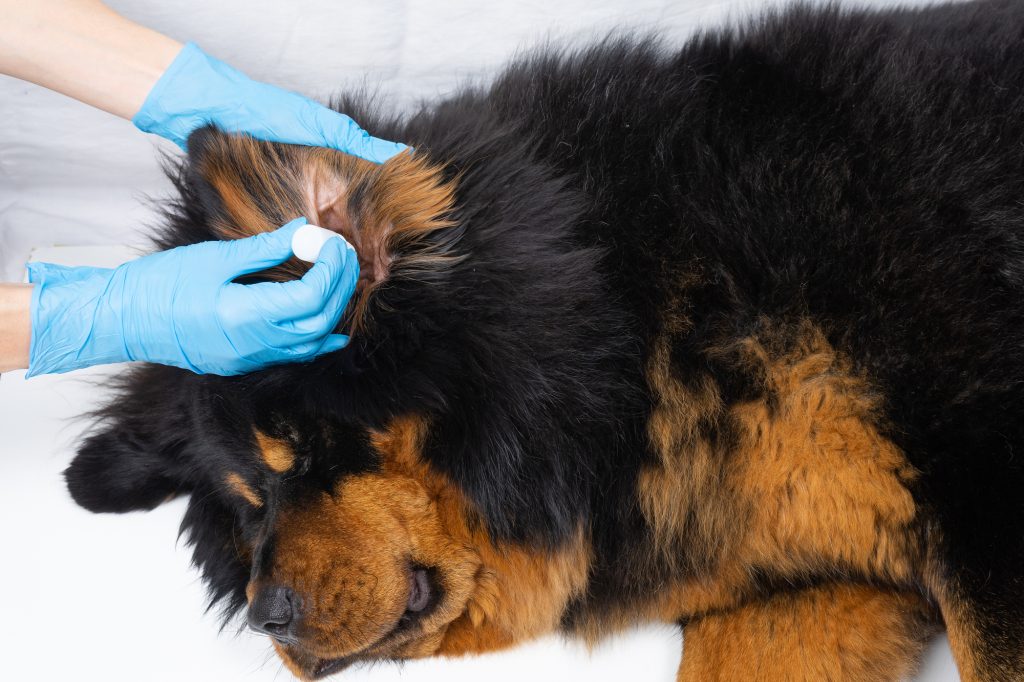
When Amanda noticed her dog, Max, scratching his ears more than usual, she initially thought it was a temporary irritation and did a routine cleaning. After Max began constantly scratching and shaking his head and had a foul odor coming from his ears, she knew something was wrong. This story probably sounds familiar to many dog owners, and the cause could be an ear mite infestation.
Ear mites are tiny parasites that cause dogs severe discomfort with hard-to-ignore symptoms. They tend to live in ear canals but can also survive on your dog’s skin. Ear mites are the second most common external parasite on dogs after fleas and are highly contagious. If your pup hangs out regularly at a dog park or has a playdate with an infected dog, it could bring home these pesky mites.
Unfortunately, ear mites are very small and hard to see with the naked eye, making it difficult to confirm an infestation without visiting a veterinarian. This guide covers what to watch for, the diagnosis process, ear mite treatment options and prevention methods. We’ll also discuss possible complications from ignoring ear mites, so you can be well-informed about your pup’s health and safety.
Symptoms of Ear Mites in Dogs
Ear mites cause various symptoms that can significantly affect your dog’s comfort and health. Understanding the signs can help you take swift action to prevent ear mites from infecting other pets your dog comes into contact with.
Common Signs
Signs your dog has ear mites are usually quite noticeable. Mites cause ear irritation, so your pup may scratch in and around its ears or shake its head to try to get rid of what’s causing the discomfort.
However, other issues can cause ear scratching and head shaking, including ear infections, allergies, foreign objects in the dog’s ear canal and moisture from summertime water activities.
Red Flags
Your dog’s ear canal issue may be caused by other culprits, so don’t attempt to diagnose it yourself. For example, an ear mite infestation can cause a putrid smell, but ear mites aren’t the only possible reason for bad-smelling ears.
Other dog ear conditions that can cause smelly odors include:
- Yeast infection
- Bacterial ear infection
- Ear wax buildup
Ear mites in dogs also typically cause brown or black wax-like secretions or debris that resembles coffee grounds inside the ear canals. Your dog may have ear mites if you spot tiny white dots in your dog’s ear discharge.
Diagnosing Ear Mites in Dogs
Confirming an ear mite infestation is crucial for your pup, other animals in your household and possibly even yourself. While rare, humans can catch ear mites from dogs when there’s close contact, such as sharing your bed with an infected animal. Because dogs living in the same household may snuggle together, if one pet has ear mites, assume all your pets have them.
Getting a professional diagnosis is key to determining if your dog has ear mites, since they’re barely visible with the naked eye. A veterinarian has the tools to look deeper into your pet’s ears to give you a proper diagnosis.
The vet will examine your dog’s ears with an otoscope to see if mites are present. They may also take a sample of the ear discharge and examine it under a microscope to diagnose ear mites in dogs. Once confirmed, work with your vet to treat ear mites.
Dog Ear Mites Treatment Options
While some home remedies can treat ear mites in dogs, relying solely on these treatments isn’t a good idea as they may not fully eradicate these parasites. Your vet can provide the most effective options for treating ear mites, which usually involve prescription medicine.
Prescribed medications may include ear drops, topical treatments or oral medications. Discuss treatment options with your vet and follow their instructions carefully to ensure success and avoid additional treatment requirements.
Always treat other dogs and pets in your home simultaneously. Otherwise, they’ll just keep reinfecting each other.

Happy Ears, Happy Dog: Prevention of Ear Mites
One of the best preventatives for ear mite infestations is the oral or topical medications you give your dog to prevent other parasites, such as fleas and ticks. Cleaning your dog’s ear canals regularly helps prevent dirt buildup leading to ear infections. It may also help prevent mites or help you catch an infestation sooner.
Only clean your pet’s ears based on their appearance and smell. To safely clean a dog’s ear:
- Fill the ear canal with a veterinarian-recommended ear-cleaning solution.
- Massage the base of the ear for about 30 seconds.
- Allow your dog to shake its head.
- Wipe out the ear canal gently with a cotton ball or gauze.
Regularly cleaning your dog’s environment can also help prevent an ear mite infection. Wash its bedding in hot water and dry it with high heat. Vacuum carpets and area rugs frequently, and clean dog toys and any surfaces your pup touches to kill ear mites.
Complications of Untreated Ear Mites
If ear mites aren’t treated promptly, they can lead to complications. Understanding these risks emphasizes the importance of timely intervention.
Problems Beyond Itching
The constant scratching from itchiness can lead to skin sores that may become infected. Scratching and head shaking can cause hematomas in the ear flaps or ruptured eardrums. Your pup could also develop a secondary bacterial or fungal infection inside its ear canal that could cause hearing loss.
Halo Collar’s Intervention
In addition to keeping your dog safe behind an invisible fence, Halo Collar’s activity tracking can act as an early warning system that something might be wrong with your furry companion. Activity charts are helpful features that show how much time your dog spends being active versus resting. Constant scratching disrupts resting periods.
Ear-tastic! Your Dog Deserves Halo Collar
If you see a dog scratching its ears, always be cautious. It could indicate an ear mite infestation that could be passed to your furry friend. Other susceptible animals include cats, ferrets and rabbits. By being vigilant, protecting your dog’s ears and using a Halo Collar, you can support your dog’s health and happiness.
The new Halo Collar 3 is the most accurate GPS dog fence, featuring AI-driven software for superior location accuracy, real-time tracking and better reception in areas with obstructions or poor coverage. These innovative collars provide a pain-free invisible fencing option that keeps your pet safe from roaming into dangerous situations.






